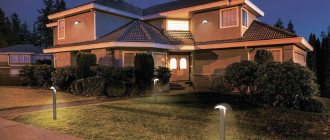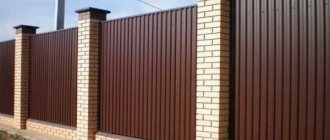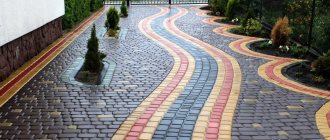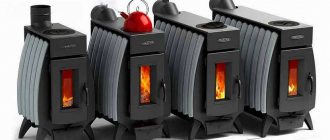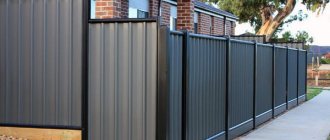The water supply to a private house located outside the centralized system is based on water supply from autonomous sources - a well, borehole or storage tank (less commonly). A feature of underground sources is the lack of pressure necessary to lift water upward. Therefore, in order to continuously supply a site or building, you need to purchase a regulating installation for water delivery - a pumping station or, in other words, a hydrophore for a private house.
The purchase of pumping equipment is based on taking into account the characteristics of all parts of the system, their compatibility, suitability for a specific source (well or well), as well as the choice of location for installation. Installation of a pumping station can be carried out at various stages: during the construction of a house, drilling a well or repair work.
For installation, you will need a closed, flat area of minimum size (1-1.5 m²), located in a utility room, basement or outdoors. If you consider the best place to be a corner in the house (bathroom, veranda, cellar), then take care of good sound insulation, even if the equipment is equipped with the necessary certificates.
- 2 Aspect #2 – volume and pressure of the unit
- 3 Aspect #3 – source of water intake
- 4 Aspect #4 – installation conditions and location
ADJUSTMENTS
After installing the electric pump (hydrophore), you should check the correctness of the adjustments for turning the pressure on and off.
The switch-on pressure should be set to approximately 1.7 - 1.8 bar. Adjustment, if necessary, is carried out using adjusting bolt No. 1 (with a spring) with the voltage turned off: turning the bolt clockwise increases the pressure, turning it in the opposite direction decreases the pressure.
The cut-out pressure should be set to approximately 2.8 – 3.1 bar. Adjustment, if necessary, is carried out using adjusting bolt No. 2: by turning clockwise we increase the pressure, by turning in the opposite direction we decrease the pressure.
Setting up the scheme
It must be remembered that good operation of the pumping station is based on the following factors:
- on the total volume of water used;
- on changes in general pressure indicators.
In other words, the total number of automated shutdowns and starts over a certain period of time may vary. It's worth considering how system pressure can swing the startup. When a tap is opened in a country house, the total volume of water in the system begins to decrease, and the air cushion, on the contrary, increases, which leads to a decrease in pressure. When the pressure drops to a minimum value, the pump automatically starts and begins pumping water until the total volume of compressed air will not decrease and the pressure will not increase. A special pressure switch quickly reacts to these indicators and turns off the pump. The maximum pressure in the tank is set at the factory, but the operation of the relay must be adjusted by hand.
Aspect #1 – equipment design
Until now, two types of hydrophores are equally actively used:
- membrane, equipped with an elastic sealed membrane that separates compartments with water and compressed air;
- membraneless, in which water and compressed air are not separated, are located in the same tank.
The membrane is a dense rubber bag that is not in contact with the walls of the tank in which it is located. Hydrophores with a membrane device are compact, smaller in size and do not require a large area for installation - an ideal option for homes with limited free space. The tank volume is on average 30-50 liters, but if necessary, you can find 80 and 100 liter models.
Diagram of a pumping station with a membrane hydrophore equipped with a self-priming pump and a water pressure sensor, the readings of which determine the operation of the pump
The self-priming motor is mounted on top (for small models, for large ones it is installed next to it) and is connected to the tank with an elastic pipe. A nipple is used to regulate the compressed air pressure. Due to its design features, the membrane device produces less noise. Some models provide the ability to replace a worn membrane. If you have to buy a replacement option, make sure it is certified, since the material (usually rubber) comes into contact with drinking water.
Diagram of a pumping station with a membraneless hydrophore, which looks like a large reservoir on supports: there is water in the lower part of the container, compressed air in the upper part
A membraneless tank is a vertically located large cylinder with a volume of 100 liters or more. To supply water complete with a membraneless hydrophore, it is necessary to purchase a self-priming vortex type pump. The optimal pump pressure should not exceed 0.6 MPa, since this figure is maximum for a large number of hydrophores.
Regulatory standards allow the use of pumps with high pressure, but subject to the installation of a safety valve, the drain of which leads to the sewer pipe.
To improve the functioning of the hydrophore and protect it from damage, a filter for additional water purification is installed on the pipe in front of the device.
The correct choice of hydrophore equipment determines the stabilization of pressure in the device and the entire water supply system, optimal pressure at each water supply point (in the kitchen faucet, in the shower, for watering the garden), and protection from heavy loads.
It should be remembered that the operation of a hydrophore is based on two factors:
- changes in pressure indicators;
- volume of water used.
That is, the number of automatic on-off switches in one hour may vary.
The standard operating scheme of a hydrophore: water fills the storage tank until the pressure switch is activated; the pump turns on again after the tank is empty and the pressure inside the tank has increased
Let's look at how pressure affects startup. Let's assume that the faucet is turned on in the house. The volume of water inside the device began to decrease, and the compressed air cushion, on the contrary, increased, which causes a decrease in pressure. As soon as the pressure reaches the minimum level, the pump automatically turns on and pumps water until the air volume decreases, therefore, the pressure does not increase. The pressure switch reacts to this and turns off the pump. The maximum pressure inside the tank is set by the equipment manufacturer, but the operation of the relay can be adjusted independently.
It is also necessary to take pressure into account when choosing a pump for irrigation:
LAUNCH
Installation and startup of the electric pump is carried out by a specialist with appropriate qualifications.
Before doing this you should do:
- install the electric pump or hydrophore unit on a flat horizontal surface;
- depending on the type of pump, supply the appropriate mains voltage 220 V or 380 V with grounding;
- prepare a suction pipe with a cross-section of 1 ¼” (32 mm) or min. 1”(25 mm); for MH1800,2200 - 1 ¼” (32 mm);
- Do not use soft (non-rigid) hoses to connect the pump to a well or well. Due to the risk of the hose being pinched by the suction pressure and cutting off the water supply to the pump. The pump will run dry, which will cause damage.
- the length of the pipe for ring wells should be selected so that the lower end of the pipe is immersed at least 30 cm below the water level;
- in the case of ring wells, attach a check valve with a receiving mesh to the end of the suction pipe, and for drilled wells (water intake boreholes) - a check valve with a mesh filter;
- For the WZ250B electric pump, it is recommended to install two check valves: one at the end of the suction hose, and the other on the hose in front of the pump. The WZ250B electric pump has the ability to self-prime from a depth of no more than 6 m;
- the horizontal section of the suction pipe must have a slope (slope) in the direction of the water intake so that at no point does a siphon form that would prevent the system from being completely and thoroughly filled with water;
- screw the suction pipe to the pump, strengthening it so that no voltage from the pipe is transferred to the electric pump;
- in an electric pump or hydrophore unit, for connections between the suction and discharge pipes, it is recommended to use sealing flax with UniPack sealant;
- connections on the suction pipe must be made hermetically (tightly) and carefully;
- check the air pressure in the expansion tank, it should be 50l tank - 2 atm; 24l tank - 1.7 atm
- Fill the electric pump and suction pipe completely with water. To do this, unscrew the filler plug located on the electric pump housing and fill the housing with water until the water reaches the edge of the hole. Before starting, tighten the plug;
- connect the pressure part of the water supply to the electric pump;
- set the electric pump in motion by connecting to an electrical installation;
- the first start-up should be carried out with a free water outlet (open tap) in order to pump out the remaining air particles in the installation;
- If the electric pump does not start pumping water within 3 minutes after switching on, then you should repeat the steps noted above in italics (depending on the parameters of the well several times). Make sure that the pump does not overheat;
- in the hydrophore unit complex, after deaeration (removal of air) and tightening of the taps, the adjustment of the pressure switch should be checked according to the description contained in the instructions;
- in the event of a malfunction as a result of improper installation of the electric pump, hydraulic elements made from artificial raw materials may be damaged;
- If during operation the WZ type electric pump does not start after the next turn on, then you should find out whether the pump impeller is blocked. For this purpose, you should use a screwdriver to try to turn the electric pump motor fan through the holes in the fan housing. If the fan of the electric pump motor does not turn, then unscrew the three screws securing the suction housing of the electric pump (see Fig. 2), remove it and clean the impeller of sand and dirt;
Read also: How to install a chain-link fence video
OPERATING THE ELECTRIC PUMP
Electric pumps can only pump clean water that does not contain solid grinding parts, such as sand. Pumping water containing excessive amounts of sand or minerals that cause stone deposits on the working elements of the electric pump will lead to premature wear and failure. Accidents caused by pumping contaminated water are not subject to warranty repairs. In this case, only paid repairs are possible.
Replacement of the oil seal if it malfunctions is carried out only at the expense of the buyer , even if it is under warranty.
When using the electric pump in winter, you should protect it from frost . If the electric pump is not used in winter or there is a possibility of its excessive hypothermia during frosts, you should carefully drain the water from the electric pump by unscrewing the drain plug contained in the lower part of the housing, and you should also unscrew the nut of the anti-vibration hose connected to the tank. A slight tilt of the electric pump while draining the water will facilitate more thorough emptying of the housing. Repeat the action several times. In WZ type electric pumps, to empty the housing, you need to unscrew 3 bolts (Fig. 2)
A pear-shaped rubber diaphragm is installed in the hydrophore expansion tank, which separates the air-filled space from the water space. If the hydrophore turns on too often with small intakes of water, this may mean that the air pressure in the tank is less than the required value, or the pear-shaped rubber diaphragm is torn.
Read also: How to obtain calcium carbide from carbon
The air pressure in tanks with a capacity of 20-25 l should be 1.5 - 2.0 bar , and in tanks with a capacity of 50-100 l: 1.7 - 2.3 bar with zero water pressure in the hydrophore equipment. The air pressure should be checked periodically (on average once a month), and if it is less or more than the above value, it should be brought to the appropriate pressure using a car pump. To inflate or deflate air, use the special valve installed at the rear of the tank. The pressure in the tank should be adjusted after turning off the electric pump from the power supply and releasing the water pressure in the system (the hydrophore pressure gauge should show a zero value).
The pressure gauge installed on the hydrophore shows the water pressure in the hydrophore, and is not intended to measure the air pressure in the tank. To measure the air pressure in the tank, use a pressure gauge designed to measure the pressure in car tires! In tanks of 100 liters or more, there is a threaded hole in the rear for mounting a safety valve or pressure gauge. If the hole is not used for the above purposes, it must be closed with a suitable plug, otherwise water will flow out of the tank.
Advantages and disadvantages of pumping stations with a hydraulic accumulator
If we talk about the advantages that a pump with a hydraulic accumulator has, the most significant of them usually include the following.
- In water pipelines served by pumping stations with a hydraulic accumulator, which is always filled, a constant availability of water is ensured.
- A hydraulic accumulator for a pumping station, the main structural element of which is a membrane that creates the required pressure of the liquid medium in the system, ensures the supply of water to the pipeline even in cases where the pump is not functioning. However, water will flow into the pipeline when the pump is not working until it runs out in the hydraulic tank.
- The use of a hydraulic accumulator eliminates such a negative phenomenon as water hammer in the pipeline system.
- Water pumps operated in conjunction with a hydraulic tank have a longer service life, as they operate in a more gentle mode, turning on only at those moments when the liquid level in the hydraulic accumulator drops to a critical level.
For any water supply system you can choose a suitable accumulator
Among the disadvantages of pumping stations with a hydraulic tank are the following.
- It is necessary to allocate a decent area for the installation of such equipment, which is explained by the large dimensions of the accumulator.
- If the pressure switch fails, the site on which such equipment is installed will be flooded with water.
- The design features of the hydraulic tank require regular (once every 2-3 months) bleeding of air from its tank, which ensures the efficient operation of such equipment (the design of the hydraulic accumulator requires the presence of a special valve for this procedure).
Pressure parameters in the accumulator
For proper operation of household plumbing fixtures in the cottage water supply, it is necessary to maintain a pressure of 1.4–2.6 atmospheres. To prevent the accumulator membrane from wearing out too quickly, manufacturers recommend setting the pressure in it 0.2–0.3 atm higher than the tap pressure.
The pressure in the water supply of a one-story house is usually 1.5 atm. This figure should be used as a starting point when adjusting the hydraulic tank. But for larger residential buildings, the pressure must be increased so that there is water in all the taps farthest from the riser. This requires more complex hydraulic calculations, taking into account the length and configuration of pipelines, as well as the number and type of plumbing fixtures.
You can simply calculate the required pressure for the indoor water supply using the formula:
(H+6)/10,
where “H” is the height from the pump to the highest point of water supply to the plumbing on the top floor of the house.
However, if the calculated pressure in the autonomous water supply exceeds the permissible characteristics of existing plumbing and household devices, then when such pressure is set, they will fail. In this case, it is necessary to select a different layout of water pipes.
The pressure in the air part of the accumulator is regulated through the spool by bleeding off excess air or pumping it up with a car pump
Unit volume and pressure
The performance of the device is calculated based on the amount of water spent in 1 hour. There are average values, but they are usually taken as a minimum. For example, a family of 4 people living in a small private house needs a hydrophore with a productivity of 2-3 m³/h. A large family living in a two-story cottage with a garden should expect a productivity of at least 7-8 m³/h. You also need to take into account your lifestyle: the frequency of water use, the number of household machines and appliances that use water, the presence of automatic watering of the lawn or garden.
As for pressure, it must correspond to all devices included in the water supply system. These include devices installed in most private houses - various types of water heaters (storage or instantaneous), single- or double-circuit boilers, boiler equipment. The pressure is set manually at the moment of connecting the equipment, using adjusting bolts according to the instructions.
Basic malfunctions of submersible pumps
If malfunctions are noticed in the operation of a submersible pump, it does not always need to be removed from the well for inspection. This recommendation only applies to pumping stations that have a pressure switch installed. It is because of this that the device may not turn on, not turn off, or create poor water pressure. Therefore, the functionality of the pressure sensor is first checked, and only after that, if necessary, the pump is removed from the well.
It will be easier to diagnose water pump malfunctions if you first become familiar with the most common breakdowns of this unit.
Pump doesn't work
The reasons that the pump does not work may be the following.
- Electrical protection has tripped. In this case, you should disconnect the device from the network and turn on the machine again. If it knocks out again, then the problem should not be looked for in the pumping equipment. But when the machine is turned on normally, do not turn on the pump again; you must first find the reason why the protection was triggered.
- Fuses have blown. If after replacement they burn out again, then you need to look for the cause in the power cable of the unit or in the place where it is connected to the electrical network.
- The underwater cable has been damaged. You should remove the device and check the cord.
- The pump's dry start protection has tripped. Before starting the device, make sure that it is immersed in liquid to the required depth.
Also, the reason that the device does not turn on may lie in the incorrect operation of the pressure switch installed in the pumping station. It is necessary to adjust the starting pressure of the pump motor.
The pump works, but does not pump
There may also be several reasons why the device does not pump water.
- The shut-off valve is closed. You should turn off the device and slowly open the tap. In the future, you should not start the pumping equipment with the valve closed, otherwise it will fail.
- The water level in the well has dropped below the pump. It is necessary to calculate the dynamic water level and immerse the device to the required depth.
- Check valve stuck. In this case, it is necessary to disassemble the valve and clean it, if necessary, replace it with a new one.
- The inlet filter is clogged. To clean the filter, the hydraulic machine is removed and the filter mesh is cleaned and washed.
Low device performance
Advice! If the performance of pumping equipment drops, you should first check the voltage in the network. It is precisely because of its reduced value that the engine of the unit cannot gain the necessary power.
Reduced performance also causes:
- partial clogging of valves and faucets installed in the water supply system;
- partially clogged lift pipe of the device;
- pipeline depressurization;
- incorrect adjustment of the pressure switch (applies to pumping stations).
Frequently turning on and off the device
This problem occurs if a submersible pump is paired with a hydraulic accumulator. In this case, frequent starts and stops of the unit may be caused by the following factors:
- the pressure in the hydraulic tank has dropped below the minimum (by default it should be 1.5 bar);
- the rubber bulb or diaphragm in the tank has ruptured;
- The pressure switch is not working correctly.
Water is supplied with pulsation
If you notice that water from the tap does not flow in a constant stream, then this is a sign that the water level in the well has decreased below the dynamic level. It is necessary to lower the pump deeper if the distance to the bottom of the shaft allows this.
You can hear the hum of the machine, but the water does not pump
If the pump hums and water is not pumped out of the well, there may be several reasons:
- “gluing” of the device’s impeller with its body occurred due to long-term storage of the device without water;
- the engine start capacitor is faulty;
- the voltage in the network dropped;
- The pump impeller is jammed due to dirt accumulated in the device body.
The unit does not turn off
If the automation does not work, the pump will work without stopping, even if excessive pressure is created in the hydraulic tank (as can be seen from the pressure gauge readings). The culprit is a pressure switch that has failed or is incorrectly adjusted.
We assemble a hydraulic accumulator with our own hands using practically improvised means
Let's try to make a very simple hydraulic accumulator with our own hands without a membrane or bulb from the most affordable materials and spare parts:
1. In order to make a hydraulic accumulator with our own hands, we will need:
- container made of food-grade aluminum or plastic (at least 30 l),
- three-quarter and half-inch tap,
- tee,
- ball valve,
- quadruple,
- pressure gauge,
- pressure meter,
- nipple for tubeless tires,
- sealant,
- washers and nuts,
- rubber gaskets.
Installation of a pumping and mixing unit for a heated floor: what to pay attention to.
Configuring relay operation
The process of setting up the relay consists of two stages: determining and adjusting the pressure in the hydrophore, as well as determining the pressure in the expansion tank.
If necessary, air is pumped up. For tanks with a volume of 20-25 liters, the pressure should be 1.4-1.7 bar. And for 50-100 liter tanks - up to 1.9 bar.
To maintain stable pressure in the water supply system, a hydraulic accumulator is installed. It is a sealed container separated by an elastic membrane. Liquid accumulates in the tank and is dispensed at the right time. What value of air pressure should be in hydraulic accumulators is determined by the manufacturer. When installing the system, you can calculate the optimal parameters and make adjustments yourself.
Self-production of a hydraulic accumulator
To save money, you can make a hydraulic accumulator yourself. In general, all materials are available, and the manufacturing process is not too complicated. However, at the very beginning, you need to decide on the future design of the device. And the easiest way would be to make a hydraulic accumulator without a membrane - this simple design is quite functional.
Preparation
First of all, you will need to prepare all the necessary materials:
- the most important part is the capacity. You can take a steel, aluminum or plastic tank. The volume should be within 100 liters. However, you should not take a tank that is too small; if its volume is less than 30 liters, it will be ineffective;
In addition, you will need nuts, washers, a set of hand tools and a drill for making holes in the tank.
Manufacturing of the device
Since the hydraulic accumulator does not include a membrane, it is very simple to make. The main thing is to do everything carefully. At the same time, you need to take into account the fact that the system will work under pressure, so the tank itself must be durable.
Organization of space for a pumping station
The choice of the appropriate configuration of water supply systems depends on the specific purposes of use. For watering the garden, for one- or two-story houses - there should be a hydrophore for each case. Differences in equipment types mainly affect the supply power and service life.
If the house has a basement, pumping stations for water supply are installed directly in it, provided that the appropriate technical parameters of the room are available:
- sufficient sound insulation;
- temperature all year round from 5 to 25 ° C;
- ventilation of the room, sewer holes and floor slope;
- area of at least 5 m with a wall height of 2.2 m;
- door block corresponding to the dimensions of the structure;
- the distance between the hydrophore and the wall should be from 0.6 m, and between the wall and the pump from 0.5 m.
Some parameters can be easily adjusted to the required technical standards. For example, increase sound insulation or insulate the room from the outside, organize heating inside, replace the door block. But it is much easier to find a more suitable place in the house or an acceptable type of hydrophore.
Small designs allow you to install equipment even under the sink. But if this interferes with comfortable living, it is moved outside the house and a special cellar is created. The requirements for it are the same: tightness (the hatch doors are covered with roofing felt sheets in addition to the lid; the walls are reinforced with waterproofing), safety (concrete walls on a reinforced mesh) and insulation (expanded polystyrene sheets from 5 cm thick). In such a pit you will need to install a light and a ladder for descent when adjustment of the hydrophore is necessary.
If the groundwater level is low, the hydrophore can be installed directly in a well or other source of water supply.
If it is difficult to think through all the nuances on your own, then a specialist who knows all the technical aspects of the issue should be invited to connect the pumping station.
Conditions and location of hydrophore installation
The compact dimensions of modern equipment allow it to be placed in almost any suitable corner - in the bathroom, on the terrace, in the utility room, in the hallway and even under the sink in the kitchen. The noise level may vary, and if it is high, additional noise insulation will certainly be required.
When installing a pumping station, you must remember the standards and requirements for the installation of electrical equipment and water supply systems in private homes. Some of the rules relate to the room for installing equipment:
- room area – at least 2 m x 2.5 m;
- room height – at least 2.2 m;
- the minimum distance from the hydrophore to the wall is 60 cm;
- The minimum distance from the pump to the wall is 50 cm.
The requirements apply not only to pumping equipment, but also to all related systems. All electrical cables, leads, lamps, lamps must have a high degree of protection against moisture. The room temperature should not be minus, the optimal option is from +5ºС to +25ºС.
In a large house, there are no problems with placing a hydrophore: it is often installed together with other pumping equipment in a specially designated room, providing easy access for maintenance and repair. Ventilation is required to ensure constant engine cooling. Insurance against accidents is the slope of the floor and sewer openings with a throughput capacity equal to the pump performance. Even the door block must match the equipment being installed so that, if necessary, the largest element of the pumping station can be brought in or removed without difficulty.
One of the best options for placing pumping equipment is in the basement of a residential building, the role of which can also be played by a cellar or basement. If the vibration and noise level of the hydrophore exceed the standards, or, more simply put, interfere with life, it is taken outside the building and placed in a concrete well - a small insulated and sealed hole in the ground. To protect the walls from crumbling, concreting with a reinforced mesh reinforced with a waterproofing film is used. For insulation, polystyrene foam sheets are used, laid in layers no thinner than 5-8 cm.
The role of the ceiling is played by a reinforced concrete slab, and the doors are a hatch that is hermetically sealed with a lock. Rainwater can penetrate into the cracks, so cover the top of the hatch with sheets of roofing felt or a plastic waterproof cover. There are design options on sale that disguise sewer and technical hatches; they are made in the form of stones or thickets of grass.
If the hydrophore is installed directly in a well or well, then it is necessary to protect the equipment as much as possible from water penetration, provide free access to the engine and pump, and insulate the room.
Descent into the well is carried out using a ladder mounted on the wall. All conditions are similar to the requirements for placement in a utility room - lighting, ventilation, sewage drainage and insulation will be required (especially in the northern regions). It should be remembered that the pumping station motor is not protected from flooding and is therefore dangerous for users. All of the above nuances should be taken into account at the stage of purchasing and selecting equipment. In contact with
How the hydrophore works
The water supply of a private house located outside the centralized system is based on the supply of water from autonomous sources - a well, borehole or storage tank (less often). A feature of underground sources is the lack of pressure necessary to lift water upward. Therefore, in order to continuously supply a site or building, you need to purchase a regulating installation for water delivery - a pumping station or, in other words, a hydrophore for a private home. The purchase of pumping equipment is based on taking into account the characteristics of all parts of the system, their compatibility, and compliance with a specific source (well or well) , as well as on choosing a location for installation. Installation of a pumping station can be carried out at various stages: during the construction of a house, drilling a well or repair work. For installation, you will need a closed, flat area of minimum size (1-1.5 m²), located in a utility room, basement or outside. If you consider the best place to be a corner in the house (bathroom, veranda, cellar), then take care of good sound insulation, even if the equipment is equipped with the necessary certificates.
Choosing a hydrophore for a summer house and a private house: basic recommendations
Autonomous water supply sources are the only alternative to centralized water supply systems. To obtain complete communication, you should think through all the nuances associated with the purchase and installation of components. And the main one is a hydrophore for a dacha and a private house, since groundwater does not have pressure to help push liquid to the surface.
Water sources
The purchase of a pumping station for a private home depends on the type of source of drinking water, which can be:
- deep well;
- well;
- water;
- central water supply;
- large tank.
In order to get drinking water from a well or borehole, you need a fairly powerful pump. Usually it works according to this principle: it turns on when drinking water is collected and turns off when all consumers in a country house are closed. The pump is adjusted using a special pressure switch. This is a rather convenient adjustable device that helps control the water supply as the pressure increases or decreases. It is worth using several types of pumps at the same time.
The accumulator engine is capable of creating high pressure, due to which water is sucked in, but it has some limitations. It is necessary to take into account not only the depth of the well, but also the horizontal extent of the system. Experts equate 9 meters of horizontal pipe to 1.5 meters of vertical pipe.
If the water level is very low, then the pumping station should be installed directly in the well, making a platform at the required height. High humidity, even with high-quality waterproofing, can lead to rapid breakdown of the hydrophore, which is why this method is used very rarely. The best option for installation is a warm and dry basement.
Judging by experience, in small houses hydrophores break quite often. This happens due to the fact that the number of times the device is turned off and on is large, because drinking water is collected quite often, but in a small volume. Any pump model has an indicator for the largest number of starts per hour, for example, up to 35 starts per hour. When the inhabitants of a country house often use water, the relay will first break due to overheating of the pump motor windings. To avoid this breakdown, you need to increase the time interval between starts. This is the main function of the hydrophore.
Small houses located in urban areas are usually connected to a central water supply system. But due to low pressure, water does not flow well to the upper floors of the building. That is why, to create a forced supply, you need to install a pumping station. It with a vortex pump and a mushroom must be connected directly to the water supply. In order to have good pressure, it is worth purchasing an inverter motor.
It follows that pumping stations are most suitable for installation in country houses with sources of drinking water, such as small wells and boreholes, poor water supply systems or reservoirs.
Which garden pump is best?
Surface pumps for providing water supply at a summer cottage are offered by many companies whose specialization is the production of installations for water supply systems. Several companies are currently market leaders.
- Jumbo;
- Whirlwind;
- Neoclima;
- Grundfos;
- Wilo.
Popular surface pump models
Among all the pump models, we can highlight those that are in greatest demand among consumers today.
- Elitech NS 600P. The peculiarity of this installation is that it has a self-priming pump in its design, and also has a steel frame. This pump can be used for pumping clean water in conventional and drip irrigation systems. The power of the model is 620 W. As for its productivity, it is at the level of 50 liters/hour. The depth from which these installations can supply water is 8 meters.
- "Jumbo 70 50 P." This model is able to work at a maximum depth of up to 9 meters. The power of this model is 1100 W. The pump capacity is 4.2 cubic meters. meters/hour.
- "Whirlwind PN 1100N". The power of this pump is 500 W. Its performance is the same as the previous model.
- "AQUARIUS BC-1.2-18U. The peculiarity of this pump is its vertical position. The power of the equipment is 690 W. It has a capacity of 4.5 cubic meters of water per hour. This model can operate at a maximum depth of 8 meters.
If in a summer cottage the source of water supply is located far away, then in this case, in order to ensure constant watering of plants and beds, it is necessary to drill a well and install a pump. Choosing a pump is a responsible matter, since there are quite a few models and each has its own performance and purpose of application. For irrigation, you need to choose a suitable model, taking into account not only the price, but also performance parameters and water supply depth.
In order not to make a mistake with your choice, you must first familiarize yourself with the types of pumping equipment and then make a choice. To avoid mistakes, it would be useful to consult with specialists who will not only help you choose an installation, but also give advice on operation.
About choosing a pump for hydrophore
It operates in continuous mode, turns on when water is supplied and turns off when all the taps in the house are closed. The pressure switch helps you adjust it - a very convenient adjustable tool that allows you to control the water supply by increasing or decreasing the pressure.
Two types of pumps can be used
One of them is the accumulator pump.
It creates pressure and, due to this, sucks in water, but has its limitations. In addition to the depth (up to 7-8 meters), it is also necessary to take into account horizontal sections: 10 meters of horizontal pipe and one and a half meters of vertical pipe lowered into the well.
Using a self-priming pump.
This method has limitations - the maximum depth is no more than 8 meters. When the water level is too low, a hydrophore pump is installed directly in the well, equipping the platform at the required height. High humidity, even with good waterproofing, can shut down equipment in advance, so this method is used only in a desperate situation. The ideal installation option is a dry, warm, specially equipped basement.
There is also an option when water is pumped using a submersible pump. Most wells have a depth of 20-40 meters, which indicates the relevance of this method. Oddly enough, in small houses pumps fail more often. This happens for one reason: the number of equipment turned on/off is greater, since water is often withdrawn, but in small quantities.
To avoid breakdowns, it is necessary to increase the interval between switching on - this is one of the most important functions of hydrophores. Private houses located in a city or village are usually connected to a centralized water supply system. However, due to low pressure, water often does not reach the second floor, so forced delivery also requires the right pump.
The hydrophore complete with a vortex pump must be connected directly to the water supply. To maintain constant pressure, it is better to choose an inverter-controlled motor. The advantage of this method is to stabilize the water supply when there is insufficient pressure in the centralized system.
Thus, hydrophores are optimal for working in private homes and cottages with water sources such as shallow wells and wells, unstable water supply systems or ponds for watering gardens.
Setting up the scheme
It must be remembered that good operation of the pumping station is based on the following factors:
In other words, the total number of automated shutdowns and starts over a certain period of time may vary. It's worth considering how system pressure can swing the startup. When a tap is opened in a country house, the total volume of water in the system begins to decrease, and the air cushion, on the contrary, increases, which leads to a decrease in pressure.
When the pressure drops to a minimum value, the pump automatically starts and begins pumping water until the total volume of compressed air decreases and the pressure increases. A special pressure switch quickly reacts to these indicators and turns off the pump. The maximum pressure in the tank is set at the factory, but the operation of the relay must be adjusted by hand.
We make a hydraulic accumulator with our own hands with minimal costs for materials
Providing running water in a dacha is not an easy task. Nobody wants to spend a lot of money on its installation, so almost all the work is done independently. When the system itself and the pumping station are already installed, you want to achieve maximum savings in energy consumption. To do this, you need to minimize the number of pump starts. In such cases, the only solution is to install the device we are considering. The article will discuss how to assemble a hydraulic accumulator from improvised means, what the pressure should be in the device, and photographic materials.
How to connect a hydrophore to a water supply system?
Most residents of high-rise buildings and country houses are faced with the problem of low or high pressure in the water supply system. A hydrophore, a device consisting of a storage tank and a pump, is called upon to resolve the unpleasant situation. Having purchased the installation, many ask a reasonable question: “How to connect a hydrophore?”
To bring the device into working condition, first of all, it is necessary to accurately understand its individual technical characteristics. Also, you should consider where the water will be taken from and the location of the device.
So, how to properly connect a hydrophore can be found in the diagram below.
Approximate hydrophore connection diagram
Firstly, the device must be installed on a flat horizontal surface in the place provided for it. How to connect a hydrophore so that the noise emitted by the device does not interfere with its operation? The best solution is to place the device indoors on a soundproofing base, then it will be securely hidden from people.
Secondly, the connection of the hydrophore to a well or other water supply point is made taking into account the depth and distance of the source. The success of the entire hydrophore connection will largely depend on how this operation is performed. So, it is better to make the connection using rigid hoses, which makes it possible to avoid squeezing the pipe from pressure when water is sucked in.
A pipe with a protective mesh at the end is immersed in a reservoir to a depth of at least 30-40 cm.
Water sources
The purchase of a pumping station for a private home depends on the type of source of drinking water, which can be:
- deep well;
- well;
- water;
- central water supply;
- large tank.
In order to get drinking water from a well or borehole, you need a fairly powerful pump. Usually it works according to this principle: it turns on when drinking water is collected and turns off when all consumers in a country house are closed. The pump is adjusted using a special pressure switch. This is a rather convenient adjustable device that helps control the water supply as the pressure increases or decreases. It is worth using several types of pumps at the same time.
The accumulator engine is capable of creating high pressure, due to which water is sucked in, but it has some limitations. It is necessary to take into account not only the depth of the well, but also the horizontal extent of the system. Experts equate 9 meters of horizontal pipe to 1.5 meters of vertical pipe.
If the water level is very low, then the pumping station should be installed directly in the well, making a platform at the required height. High humidity, even with high-quality waterproofing, can lead to rapid breakdown of the hydrophore, which is why this method is used very rarely. The best option for installation is a warm and dry basement.
Judging by experience, in small houses hydrophores break quite often. This happens due to the fact that the number of times the device is turned off and on is large, because drinking water is collected quite often, but in a small volume. Any pump model has an indicator for the largest number of starts per hour, for example, up to 35 starts per hour. When the inhabitants of a country house often use water, the relay will first break due to overheating of the pump motor windings. To avoid this breakdown, you need to increase the time interval between starts. This is the main function of the hydrophore.
Small houses located in urban areas are usually connected to a central water supply system. But due to low pressure, water does not flow well to the upper floors of the building. That is why, to create a forced supply, you need to install a pumping station. It with a vortex pump and a mushroom must be connected directly to the water supply. In order to have good pressure, it is worth purchasing an inverter motor.
It follows that pumping stations are most suitable for installation in country houses with sources of drinking water, such as small wells and boreholes, poor water supply systems or reservoirs.
If the electric pump does not pump or suck in water, you should check:
- presence of water in the well;
- is the water intake valve with the receiving mesh completely immersed in water;
- is there any leakage in the suction pipe;
- whether the receiving grid is blocked by sewage;
- whether the self-suction depth is exceeded;
- whether a siphon with air has formed in the suction pipe (for example, when part of the pipe is higher than the pump).
The hydrophore tank has guaranteed resistance to corrosion from the inside. To ensure protection against corrosion from the outside, the user independently carries out additional anti-corrosion protection every six months.
Electric pumps or hydrophores do not have protection against dry running in the absence of water. If there is a possibility of the above occurring, you should definitely use protective devices ( can be purchased at Belsilon ODO ). In the event of a device failure caused by dry running or lack of water supply, only paid repairs will be possible!
Electric pumps or hydrophores cannot operate in rooms or places with high humidity (eg basements, wells) and in rooms without proper ventilation. It is unacceptable to expose the pumping unit to atmospheric factors (rain, snow) . Operation under such conditions may cause damage to the motor or pressure switch. Repair in this case will be possible only at the user's expense.
Connection sequence
Connection to a well and borehole
First, let's look at how to properly connect a pumping station to a well or well.
In this case, we will pay attention specifically to the two-pipe connection diagram, since it is more complex. We work in this order:
- First, we assemble the ejector with our own hands. As a rule, this is a monolithic unit made of cast iron, which has three outlets.
- We install a coarse filter made of propylene mesh at the lower outlet of the ejector.
- There is a plastic socket at the top of the cast iron structure. You need to put a squeegee of the required length with a diameter of 32 mm on it.
- Next, you need to assemble a squeegee to fit the diameter of the pipeline. Usually two parts with adapters are enough for this.
- A bronze coupling is installed at the outlet of this outlet. With its help, the transition to the polyethylene pipe will be made.
- Next, trenches are dug from the hydraulic structure to the house below the freezing point of the soil.
- Water pipes are laid in the trenches.
- A cap is installed at the exit of the well casing. If you can't find it, you can use a knee with a smooth angle.
- To connect the ejector to the water supply pipeline, couplings are used.
- Before lowering the second end of the pipe, it must be passed through the elbow at a right angle.
- Polyurethane foam is used to seal the space. After this, the pipe can be connected to an adapter (angular), and it, in turn, must be connected to the outer part of the water supply.
- Now you can lower the ejector into the well. In this case, the immersion depth must be determined in advance, taking into account the elevation of the top of the casing pipe.
- The head is fixed to the casing using reinforced sanitary tape.
Features of connecting to the water supply
If there are centralized water supply networks near your home, then the pumping station can be connected to them. Typically, the need for such a connection arises when the pressure in the system is too low, which does not allow the heating equipment to function efficiently and correctly. This situation can arise for several reasons:
- the hydrogeological conditions of the area have changed;
- outdated equipment is used;
- As the number of residents has increased, water consumption needs have become greater.
To connect to the central water supply you need to perform the following sequence of actions:
- The place where the pipeline will be disconnected is selected in advance. After stopping the water supply, the water supply is divided into two parts.
- So the part that comes from the city highway is connected to the storage tank.
- The liquid from this tank must flow through pipes to the pumping unit. A pipeline leading to a residential building is connected to the outlet from the pump.
- Next, the electrical wiring is laid and connected.
- After this, you can perform a test run, configure and adjust the equipment.
The main thing in setting up a pumping unit is to select the correct pressure in the system. To adjust the equipment, a small amount of water (about 2 liters) is poured into a special hole on the pump unit. Now you need to open the tap and measure the pressure in the system at which the pump turns off and on.
If the pressure at which the unit operates does not fall within the specified limits, it is necessary to adjust the device. It's very easy to do this:
- The cover on the pressure switch opens.
- To adjust the device shut-off pressure, use a screw marked “DR”. It needs to be twisted towards decreasing or increasing depending on the results.
- To adjust the switching pressure, you need to turn the screw marked “P”.
- After adjustment, the cover on the relay is put in place.
Also, do not forget that the long-term and proper operation of pumping equipment is affected by the composition of the water, namely various admixtures of sand and clay. To protect the equipment from impurities, a filter is installed at the suction inlet of the station.
Vortex
In vortex submersible pumps, water is taken in and expelled using a single impeller with blades, which is located in the upper part of a vertically suspended housing next to the outlet pipe. To reduce hydraulic losses, the design provides for a very small distance between the side edge of the vortex wheel disk and the working chamber - this makes it impossible for vortex devices to operate in an environment with sand particles.
Vortex-type devices have good pressure characteristics (the height of liquid rise reaches 100 m) and average pumping volumes (about 5 m3/h).
Although vortex electric pumps are rarely used in everyday life, there are Belamos TM, Sprut, Vikhr, NeoClima, Pedrollo Davis models on the market.
Rice. 7 Vortex submersible pump - design and appearance
Centrifugal
Centrifugal devices have achieved such widespread popularity due to the following properties:
- Their efficiency factor (efficiency) is the highest of all analogues; in large-sized industrial units it reaches 92%, in household models it reaches 70%.
- Structurally, the working chamber is designed in such a way that the liquid enters the central part of the centrifugal wheel and is pushed out through the side pipe. This makes it possible to make multi-stage centrifugal devices in which the ejected liquid is fed to the axle of the next wheel, which further increases its pressure. Thanks to the use of several centrifugal wheels with separate working chambers (stages), it is possible to obtain pressure parameters in the system that are several times higher than those of other pumping equipment (in household models, the pressure does not exceed 300 m).
- Centrifugal types are capable of pumping liquid in large volumes at high pressure; for domestic use, this figure rarely exceeds 20 cubic meters per hour.
- Centrifugal-type units are less susceptible to the effects of small sand particles on the working mechanism; they are widely used in sand wells, choosing a model to work with the appropriate particle size specified in the passport.
- A significant advantage of centrifugal types is their high level of automation; the world's leading manufacturers of pumping equipment (Grundfos, Pedrollo, Speroni, Dab) equip their devices with units with frequency control of the impeller rotation speed. This innovation allows not only to significantly save energy when operating the electric pump (up to 50%), but also to significantly increase its service life.
If we list all the manufacturers of centrifugal pumps that present their products on the domestic market, the list will be quite lengthy, so we will limit ourselves to the leading global manufacturers listed above. Among the domestic brands, the most famous are Aquarius, Gilex Vodomet, Vikhr, Belamos, Caliber, Unipump.
Rice. 8 Centrifugal submersible pumps - design and materials using the example of Grundfos SBA
Connection diagram of the pumping station to the well: installation of the pipeline
For optimal operation of the water supply system, an unimpeded flow of liquid from the well to the point of consumption should be organized. That is why the water supply system must be installed correctly.
Please note that pipes may freeze in winter. For this purpose, installation is carried out below the ground freezing level. You can also insulate the pipeline.
Pipeline connection diagram:
- First you will need to dig trenches. At the same time, they make a slight bias towards the source of water intake.
- Holes are made in the walls and base of the trench at the required depth.
- You will need to make a platform for mounting equipment in the walls of the well.
- The next step is laying the pipes.
- The pumping station is equipped with support legs. They are fixed to the site using anchor bolts. This is done so that the equipment does not sink under the influence of constant vibrations.
- Next, the pipeline is connected to the equipment on site.
The best pumping station for home and garden KARCHER BP 3 Home (800 W) made of stainless steel
The rating of pumping stations for a private home opens with a model from KARCHER. The design is intended for organizing water supply for household needs in a house or country house. The model is easy to install. It connects to tanks or wells up to 8 m deep.
KARCHER BP 3 Home (800 W)
KARCHER BP 3 Home (800 W)
- thermal protection;
- compact dimensions;
- centrifugal pump type.
The pumping station is equipped with a tank with a capacity of 19 liters, which allows you to maintain good water pressure. The device automatically turns off when liquid supply is not required. The model is equipped with a check valve.
Product parts are made of stainless steel, which ensures long service life. Design features include a built-in pressure gauge, which improves maintenance. KARCHER BP 3 Home is characterized by low energy consumption.
The device is installed on the surface and is easily secured using bolts. The waterproof switch is located on the body.



